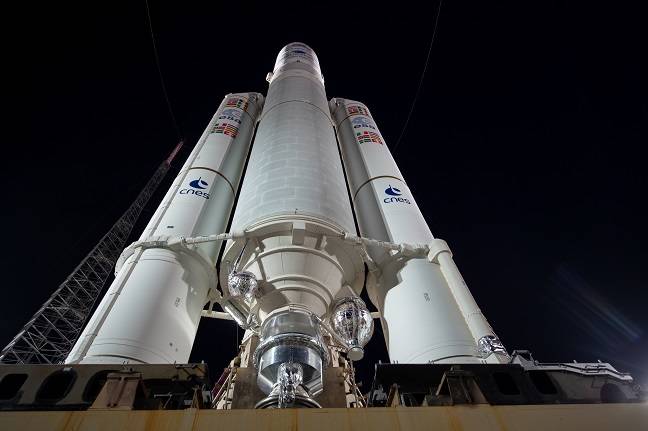On Tuesday July 4, the last Ariane 5 rocket will blast off from the Kourou spaceport in French Guiana. As the rocket’s red glare fades, Europe will be without a heavy-lift rocket for the first time in decades, with no reusable one in sight.
It will be quite an Independence Day for ArianeGroup, Europe’s domestic rocketry business. It’s going to have to buy launches from US-based SpaceX for a while, given the first Ariane 6 rocket – in development since 2014 – isn’t expected before the end of the year. And it’s likely to be delayed further – basic engine tests are still ongoing.
“Europe … finds itself today in an acute launcher crisis with a (albeit temporary) gap in its own access to space and no real launcher vision beyond 2030,” Josef Aschbacher, director general of the European Space Agency, warned in May.
The Ariane 5 has been the workhorse of European orbital delivery for nearly 30 years, albeit with some issues at first. The first launch, on June 4, 1996, had to be destroyed after faulty software caused it to veer off course. Since then, the rocket has a success rate of over 95 percent.
The venerable vehicle has had 111 successful launches from a total of 116. When the James Webb Space Telescope launched last Christmas, NASA told The Register that Ariane 5 was chosen as “a safe pair of hands,” for the instrument’s delivery nearly a million miles from home.
While reliable, the Ariane 5 was also relatively expensive to launch, slow to set up, and could only be used once. By comparison, SpaceX has lofted over 180 Falcon 9 rockets since 2018. In many cases, barring the odd “rapid unscheduled disassembly,” it has also retrieved and reused the first stage of the booster, which accounts for around 70 percent of the vehicle’s cost.
“SpaceX has undeniably changed the launcher market paradigm as we know it,” Aschbacher explained.
“With the dependable reliability of Falcon 9 and the captivating prospects of Starship, SpaceX continues to totally redefine the world’s access to space, pushing the boundaries of possibility as they go along. Once successful, Starship will carry payloads of around 100 tons into low Earth orbit while reducing the launch cost by a factor of ten. Falcon 9 aims to launch 100 times in 2023.”
Meanwhile, ArianeSpace’s other rocket, the lightweight Vega-C, is still grounded. A launch failure in December 2022 saw a lot of very expensive hardware fall into the Atlantic after a dodgy rocket nozzle caused problems. It’s expected to fly again in the next few months, but has a tiny payload capacity compared to its competitors.
ESA has already started using SpaceX’s kit, sending up the Euclid satellite on Saturday, and has confirmed other missions in the short term. With Russian orbital delivery off the cards due to sanctions over the illegal invasion of Ukraine, ESA and other European customers are having to go to the US for heavy lifting. The EU is reportedly seeking a contract with SpaceX to fill up the gap in service.
Unknown pleasures
The Ariane 6 heavy rocket has been in development for around a decade and still isn’t ready, but should be a reliable workhouse for years to come, Aschbacher suggested.
It already has 25 planned payloads, but there’s still a long way to go before it’s the reliable and trusted platform its predecessor was. New rocket designs are notoriously prone to mishaps and the first few launches will be watched closely.
Ariane 6 is also still a single-use vehicle, and will be able to resupply the International Space Station. The two-stage rocket is capable of lifting an impressive amount, but there’s none of the cost savings you get from reusable rockets. And SpaceX’s Starship is looking increasingly close to outclassing every other commercial rocket on the planet.
That’s not to say ArianeSpace doesn’t have ideas on the reusability front. It’s currently developing a Smart Upper Stage for Innovative Exploration (Susie), a reusable spacecraft that sits atop the Ariane 6. Susie is designed to deliver up to five astronauts and cargo to the International Space Station and into lunar orbit to support the attempt to return to the Moon.
The initial designs will be automated freight delivery vehicles but crewed missions are planned later. The spacecraft is designed to return to Earth by skimming – using a lifting body design through the atmosphere at Mach 25 before extending aerodynamic surfaces to reach a safe speed for a vertical rocket landing, carrying seven tons of cargo.
Susie provides an obvious role for the Ariane 6 but there’s a lot of development still to be done for the basic design, before even considering putting humans on board. Meanwhile SpaceX, Boeing and others have their own designs for such craft.
The Ariane 5 may be on its last ever launchpad, but it’s had an impressive career by hitting a sweet spot in the market for orbital delivery. Its successor is facing a much rougher ride.
Source: The Register















